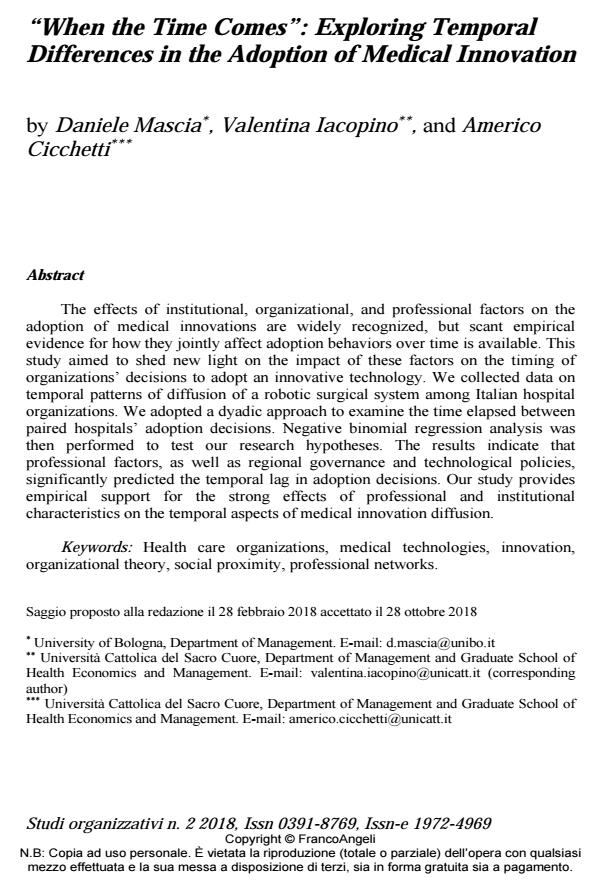"When the Time Comes": Exploring Temporal Differences in the Adoption of Medical Innovation
Titolo Rivista STUDI ORGANIZZATIVI
Autori/Curatori Daniele Mascia, Valentina Iacopino, Americo Cicchetti
Anno di pubblicazione 2019 Fascicolo 2018/2
Lingua Inglese Numero pagine 26 P. 62-87 Dimensione file 581 KB
DOI 10.3280/SO2018-002003
Il DOI è il codice a barre della proprietà intellettuale: per saperne di più
clicca qui
Qui sotto puoi vedere in anteprima la prima pagina di questo articolo.
Se questo articolo ti interessa, lo puoi acquistare (e scaricare in formato pdf) seguendo le facili indicazioni per acquistare il download credit. Acquista Download Credits per scaricare questo Articolo in formato PDF

FrancoAngeli è membro della Publishers International Linking Association, Inc (PILA)associazione indipendente e non profit per facilitare (attraverso i servizi tecnologici implementati da CrossRef.org) l’accesso degli studiosi ai contenuti digitali nelle pubblicazioni professionali e scientifiche
The effects of institutional, organizational, and professional factors on the adoption of medical innovations are widely recognized, but scant empirical evidence for how they jointly affect adoption behaviors over time is available. This study aimed to shed new light on the impact of these factors on the timing of organizations’ decisions to adopt an innovative technology. We collected data on temporal patterns of diffusion of a robotic surgical system among Italian hospital organizations. We adopted a dyadic approach to examine the time elapsed between paired hospitals’ adoption decisions. Negative binomial regression analysis was then performed to test our research hypotheses. The results indicate that professional factors, as well as regional governance and technological policies, significantly predicted the temporal lag in adoption decisions. Our study provides empirical support for the strong effects of professional and institutional characteristics on the temporal aspects of medical innovation diffusion.
Il processo di adozione delle tecnologie sanitarie è al centro del dibattito scientifico ed istituzionale nei contesti odierni. Il costo delle soluzioni tecnologiche, e il loro progressivo utilizzo nell’ambito dei processi di cura, rendono essenziale un’attività di selezione di quelle tecnologie realmente capaci di generare valore. Comprendere i fattori in grado di accelerare o rallentare il processo innovativo è quindi attività estremamente utile ad adottare soluzioni organizzative idonee al contesto odierno e ad implementare tecnologie capaci di generare un impatto positivo sulla salute. Questo studio analizza, in particolare, gli effetti dei fattori istituzionali, organizzativi e professionali sull'adozione delle innovazioni sanitarie, ed è volto nello specifico a comprendere come tali dimensioni influenzino congiuntamente le scelte temporali di adozione. Selezionando una specifica tipologia di robot chirurgico quale oggetto dello studio, sono state raccolte informazioni sul relativo processo di diffusione all’interno del Servizio Sanitario Nazionale italiano e sono state investigate le decisioni di adozione degli ospedali, con riferimento alla temporalità di tali scelte. I risultati della ricerca indicano che i fattori professionali, così come la governance regionale e le politiche tecnologiche, incidono sulla temporalità delle decisioni di adozione da parte delle organizzazioni.
Parole chiave:Organizzazioni sanitarie, tecnologie sanitarie, innovazione, diffusione, progettazione organizzativa, prossimità sociale, reti professionali.
Daniele Mascia, Valentina Iacopino, Americo Cicchetti, "When the Time Comes": Exploring Temporal Differences in the Adoption of Medical Innovation in "STUDI ORGANIZZATIVI " 2/2018, pp 62-87, DOI: 10.3280/SO2018-002003